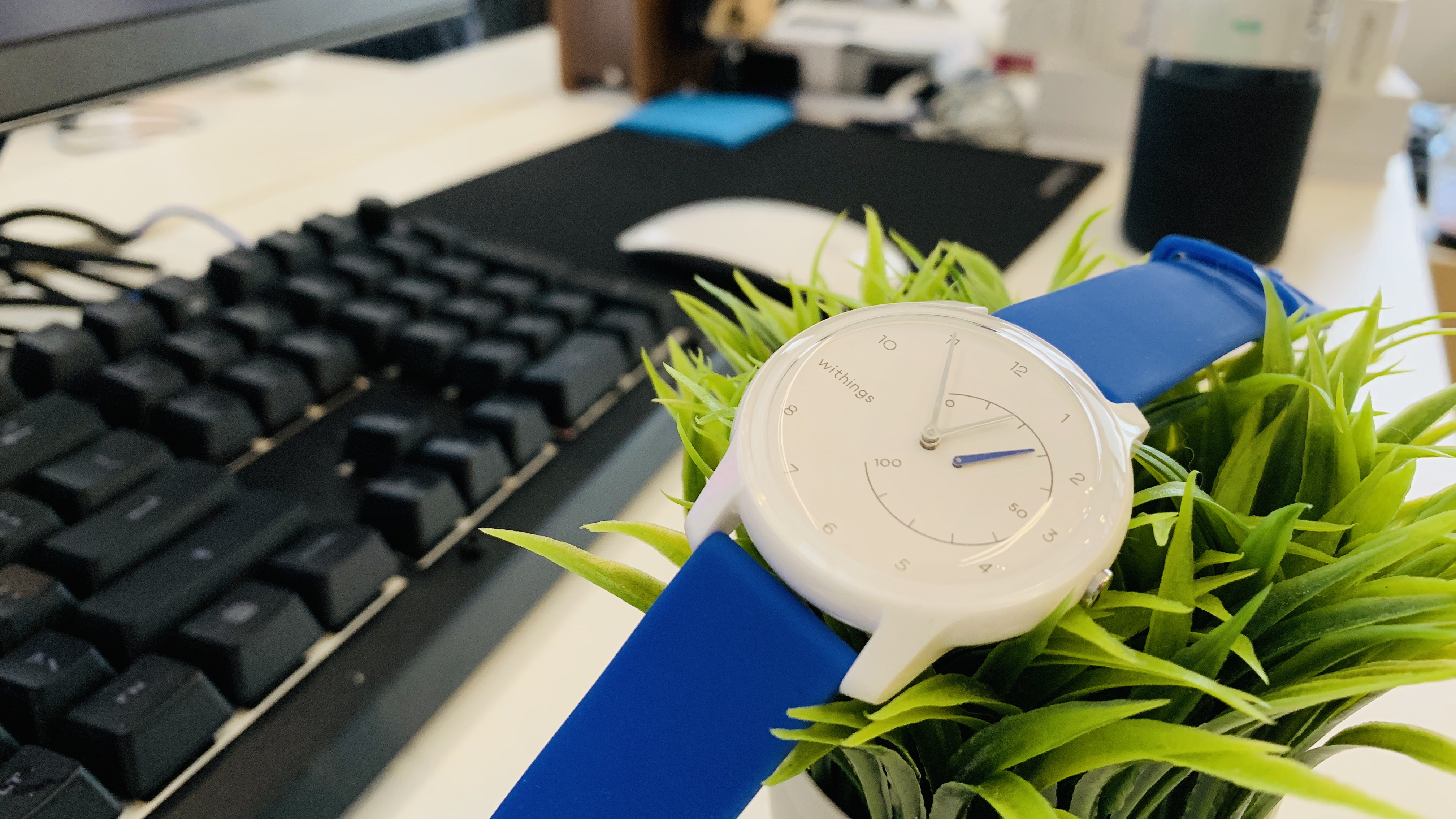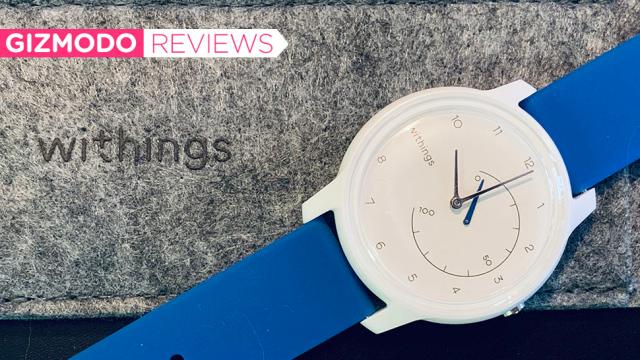With smartwatches, as with other technologies, you expect them to get more advanced with each iteration. The Apple Watch Series 4 introduced ECG measurements right onto the wrist. Since its Ionic smartwatch, Fitbit added red LED Sp02 sensors to each of its devices for some future sleep apnea-related feature that it hasn’t revealed. Samsung brought longer lasting battery to its Galaxy Watch, and then quietly added beta testing for blood pressure measurements to the Galaxy Watch Active.

Withings Move
What is it?
A basic fitness tracker disguised as a smartwatch
Price
$US70 ($98)
Like
18-month battery life. Super affordable.
No Like
No notifications. Materials feel cheap.
Editor’s Note: We’re yet to get local pricing and a release date for this bad boy.
Meanwhile, the Withings Move does the exact opposite. It’s incredibly pared down—no notifications, no continuous heart rate monitoring, and just the bare necessities when it comes to tracking metrics. Its main selling points are its colourful, Swatch-esque design, 18-month battery life, and its $US70 ($98) price. I’d lump it in with the many other analogue-hybrid smartwatches out there, except without any notifications, it’s more of a fitness tracker parading around like a normal watch.
As far as design goes, the Move heavily resembles all the Withings watches came before it. It has the same elegant circle case with analogue hands, along with a sub dial that tracks what percentage of your daily step goal you’ve completed. That’s it—no more, no less. Comparatively, the Withings Steel HR Sport has an additional monochrome LED screen that displays your steps, heart rate, distance travelled, and calories burned.
Whereas the Steel HR Sport goes for a sleeker black-and-white aesthetic, the Move is all about colour. Most of the colorways feature a bright pop of either blue, coral, or mint green—though there is a more understated black-and-yellow option. While I appreciated the Move’s playful look while taking photos, up close it’s hard to shake the feeling that you’re wearing a kid’s watch. The case and display are clearly made of plastic, and not the kind that can masquerade as a more expensive material. Combined with the silicone straps, what you end up with is a very cheap-feeling watch. The only redeeming factor of Withings cutting so many corners to lower cost is battery life. It’s powered by a coin-cell battery, which means it’ll last around 18 months with zero charging.
You know, all that would be fine if the Move delivered on something unique. Sadly, it doesn’t. Because you get zero readable notifications on this thing, so you’re still tethered to your phone for everything. The only thing you can glean from a glance is your step count percentage and the time. That can be a good thing if you’ve got notification fatigue, but for most people, it defeats the purpose of a smartwatch. This is doubly true when you consider that most smartphones these days are perfectly capable of tracking steps, distance travelled, and sleep.
That’s not to say the Move does nothing at all. It tracks steps, distance, and calories burned. It also measures sleep quality, and it is water resistant to 5 ATM, which is the minimum rating you want before jumping into the pool. The Move also features connected GPS—meaning you can use your phone to track outdoor runs and monitor metrics like distance, pace, and elevation. You can also use the Withings Health Mate app to set silent, vibrating alarms.
To test accuracy, I took the Move with me on a 5km outdoor run. For distance, I separately recorded the run using the Map My Run app, as well as on an Apple Watch Series 4. For distance, the Move slightly overestimated my run at 5km, while the Apple Watch delivered a more accurate distance of 5km. The Move also logged 5,481 steps on this run, whereas my Yamax SW-200 Digi-Walker control pedometer recorded 5,717 steps for a difference of 4.1 per cent. With regards to all-day step count, the Move counted 11,300 steps to the Apple Watch’s 13,444 steps. That’s a sizable difference of 2,144 steps, which for me translates to about a mile of walking.
Overall, this is about what you’d expect from a casual, aesthetics-first fitness tracker-smartwatch hybrid. It’s not precise, but it more or less is decent at delivering a ballpark estimate of your daily activity. That extends to the Move’s sleep tracking as well. While it did a good job of recognising when I fell asleep and woke up, it only did a so-so job measuring my sleep stages. My cat will not stop yowling bloody murder at 3 a.m. every morning until I crawl out of bed and feed him—yet the Move marked my nights as extremely restful with zero interruptions.
So if the Move isn’t helpful when it comes to notifications, and offers less accurate tracking than a basic, similarly priced tracker like the Fitbit Inspire—who is this even for?
I have a hard time imagining the Venn diagram intersection of “People who only want basic metrics” and “People who categorically refuse to wear fitness bands” is extremely large. Likewise, I’m not sold on the idea that people who value style over functionality are going to be hugely impressed with the Move’s design. There are better options like the much more attractive Misfit Path, which for about $US80 ($112) extra delivers all the same features as the Move, plus notifications.
The more enticing option is the Withings Move ECG, which was introduced earlier this year at CES. The only problem is that Withings is waiting on FDA clearance for the device, so it’s unclear at the moment when it’ll be available. Still, with 12 hours of battery life, ECG capability, and a $US130 ($182) price tag, that would’ve at least been a compelling low-cost alternative to the Apple Watch.
Without ECG, the Move feels rudderless—a product without an audience, or really a reason for existing. At best, it’s another sign that companies are starting to think about innovating entry-level smartwatches. With Apple, Fitbit, and Samsung dominating high-end, luxury offerings, there’s definitely space for other smartwatch makers to figure out a sub-$US150 ($200) watch with streamlined features and elegant design. The Fitbit Versa Lite Edition comes closest at $US160 ($250 in Australia), but like the Move, its colour options are a bit too gaudy and oversaturated. Meanwhile, the Withings Move is an admirable attempt at a $US70 ($98) smartwatch, but it simply misses the mark.
READ ME:
-
Colourful design is refreshing, but it looks chintzy and childish up close due to its cheap materials.
-
Great price at $US70 ($98), but you give up heart rate monitoring, and its tracked metrics (steps, distance, sleep, calories) are more general than precise.
-
Zero notifications, so you’ll still be checking your phone all the time.
-
Yay for 18-month battery life! No charging thanks to its coin-cell battery.
-
Connected GPS, and swim-safe.
